Motivation and goals
Intro to motivation
How we can understand motivation
Motivation is a complex term, and we can understand it from different perspectives: spiritual, neuroscience, psychological, psychotherapy, life hack, and others.
To fully grasp the concept, we should view motivation as an umbrella term because it includes different concepts. Some of them are intrinsic value, outward motivation, fulfilling purposes, and likelihood of success.
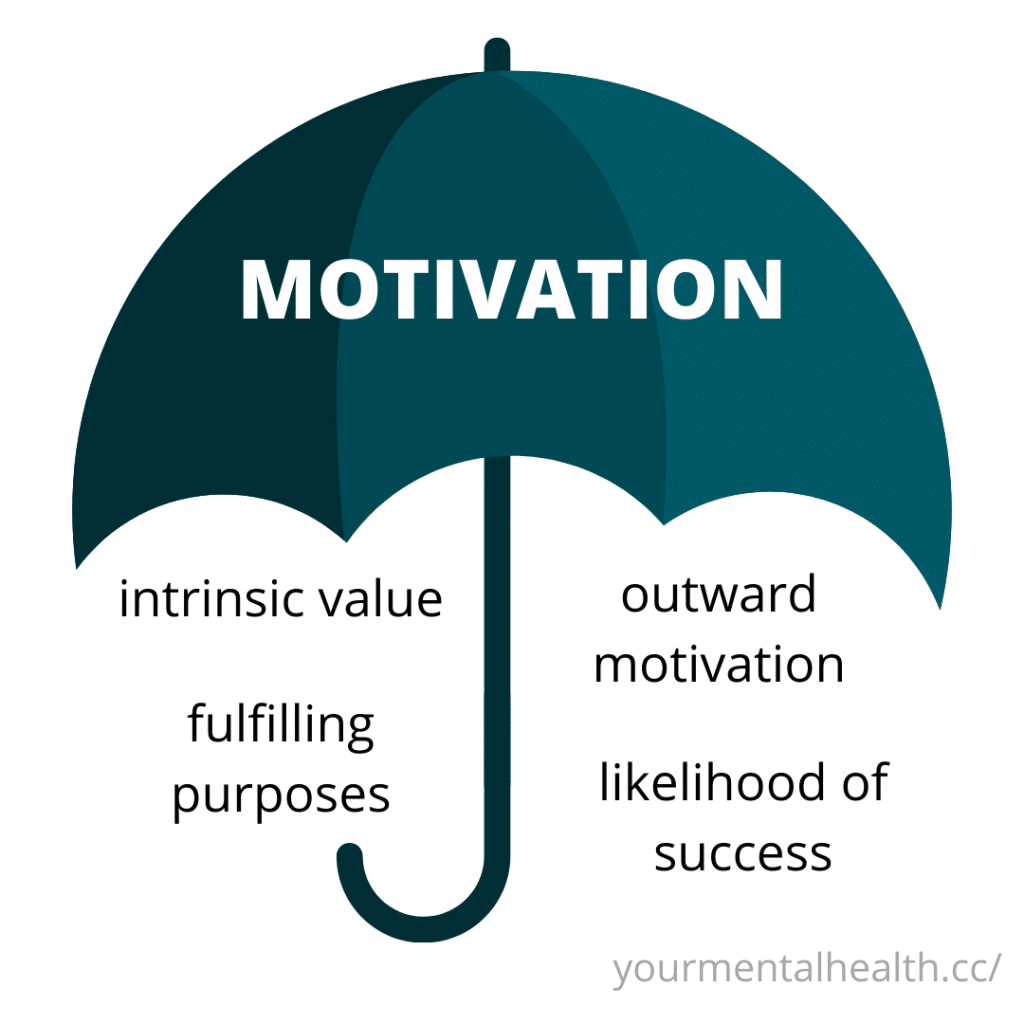
Any individual component of motivation is not responsible for what we see; it's a combination of all of them, much like a group is more than the sum of its parts.
The problem is that when people say they're not motivated, they usually don't know which one of these factors is wrong.
What happens is that sometimes we have a single objective that we seemingly can't achieve, but most often than not, we mistake where the problem is. So, for example, someone that says they're too ugly to date; the problem is probably in their self-worth and consequent confidence, not actually in their appearance.
Also, motivation is a term that is designed from external observation. If you look within yourself, you won't find motivation; you'll find emotions, desires, etc. So even if you talk to someone motivated, they probably won't say they're highly motivated; instead, it's more of a profound feeling that keeps them going.
Motivation has proved to be a popular topic lately, with several different success Youtubers and lifehacks around the internet. It isn't uncommon to scroll through your timeline and find a "recipe to success" video or article. The problem is that they won't be able to tailor their advice to people consuming this content that doesn't necessarily apply to them.
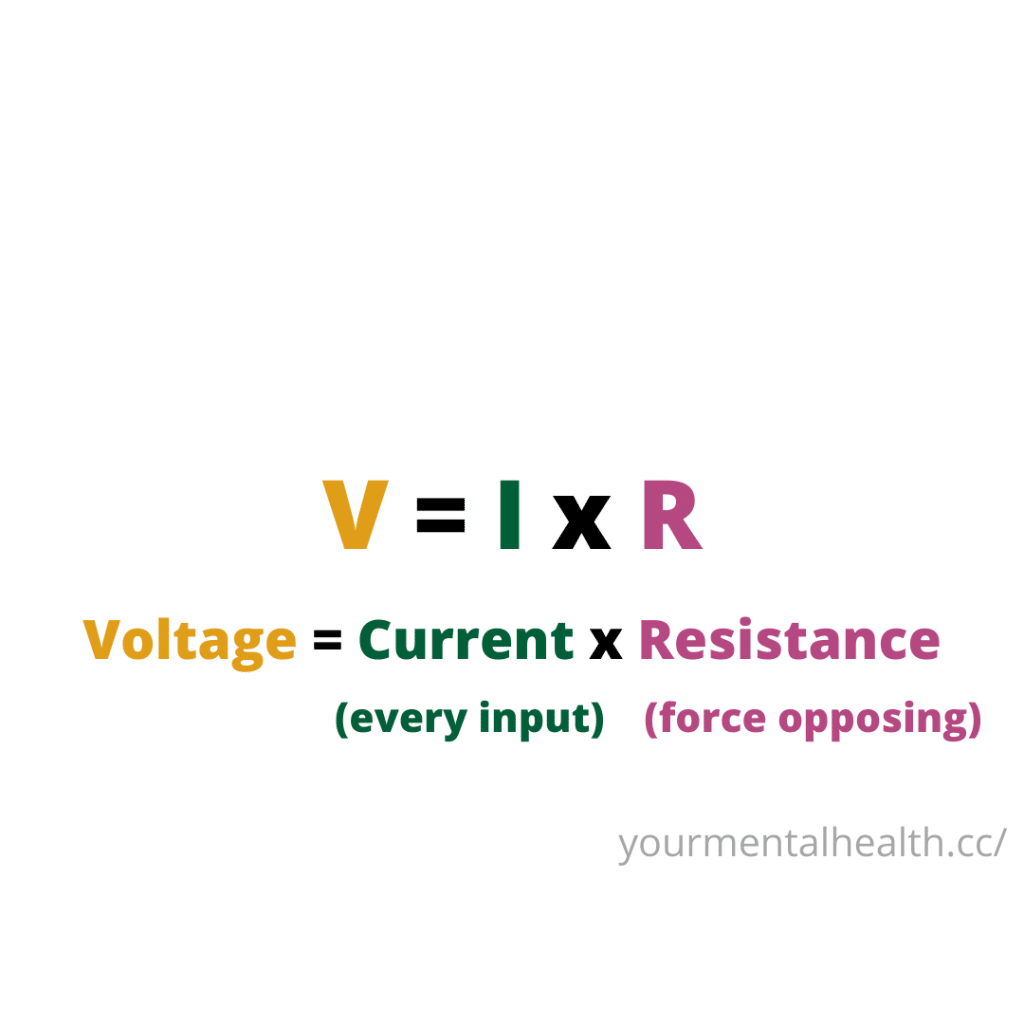
Goal setting and motivation
We can understand motivation under a basic premise:
This is Ohm's Law, and it makes a lot of sense when applied to motivation.
The I stands for current, and it's what we put into the circuit; it's the energy input. The R stands for resistance, and it's the force that the current has to act against; it's a force opposing what we're trying to do. Finally, the V stands for voltage, and it's the potential difference from the start point to the endpoint.
When we translate this equation in motivation and psychological resistance terms, we end up with this:

To better understand this, we can reflect on human behavior. When we think about a behavior, there's the intent that people put in; the resistance they have to overcome; then the action they take towards the end. These are the three dimensions of goal-oriented behaviors.
Most people have a problem with goal-setting and motivation because they don't understand that all three of these things can be acted on.
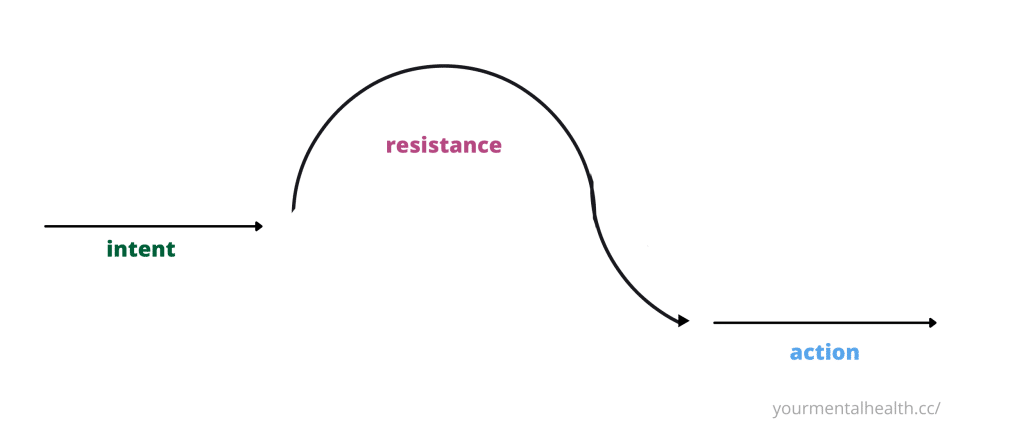
In its turn, willpower is a limited resource that you can use to power through this equation. I can expend a certain amount of willpower to overcome this resistance hump and take action one time. I can still keep using a significant amount of willpower to overcome the resistance, but it's not sustainable.
We see this pattern, for example, with students that aren't happy with what they're doing. They can start the semester with a full-charged "battery" of willpower and use it to study for the first month, but they're burnt out and unhappy by the end of the semester.
That's why we'll focus on understanding intent, resistance, and action.
Intent
The intent comes from desires ("want to do"), pressure from others ("should do"), values, or duty/obligation.
Examining these four types of intents, we understand that many times the goals that people have for themselves aren't truly their goals.
One example is people that have successful jobs but aren't happy with what they're doing. They may have a particular thing (in this case, the job) that they feel they should do, but they value something else.
So often, what keeps people stuck is that their intents are not clarified. As a result, there's a conflict of intents, and this is why they stay stuck.
When people are stuck, they're often ambivalent. They're on the fence and conflicted, which means that there's a pro side and a con side to their behavior. Many times, people cannot see the pros in their current behavior, which leads to self-judging.
For example, someone that plays video games all day instead of studying. They feel conflicted and don't see a pro side maintaining their gaming, so they feel stupid and lazy. But there's actually a benefit from gaming all day.
Our brain is continually making calculations on the costs and benefits of our behavior and the likelihood of success.
From this calculation, we opt to act or not.
One of the ways to follow a path that'll motivate us is to clarify values and desires so that we can engage in the correct behavior. Clarifying ambivalence and understanding our behavior leads us in the right direction.

Resistance
When someone has a clear intent and tries to engage in a problem, the more resistance there is, the less likely they are to engage in this behavior.
The two main contributions to resistance are emotions and ego. It mainly manifests as "stuck behaviors"; for example, when people watch Youtube all day, do drugs all day, procrastinate, etc.
People usually do this to keep themselves in the present and shut down negative emotions.
The worst people feel about themselves, the likelier they are to engage in these behaviors.
We often understand what we have to do to change our behavior; we just don't know why we're unable to do it. This is due to our blindness when it comes to our resistance.
Recognizing our blind spots in terms of emotion is how we overcome our resistance.
We could compare resistance to a clogged pipe. Most people pump more energy and effort into one end of the pipe to achieve their goals, but this only leads to burnout and frustration.
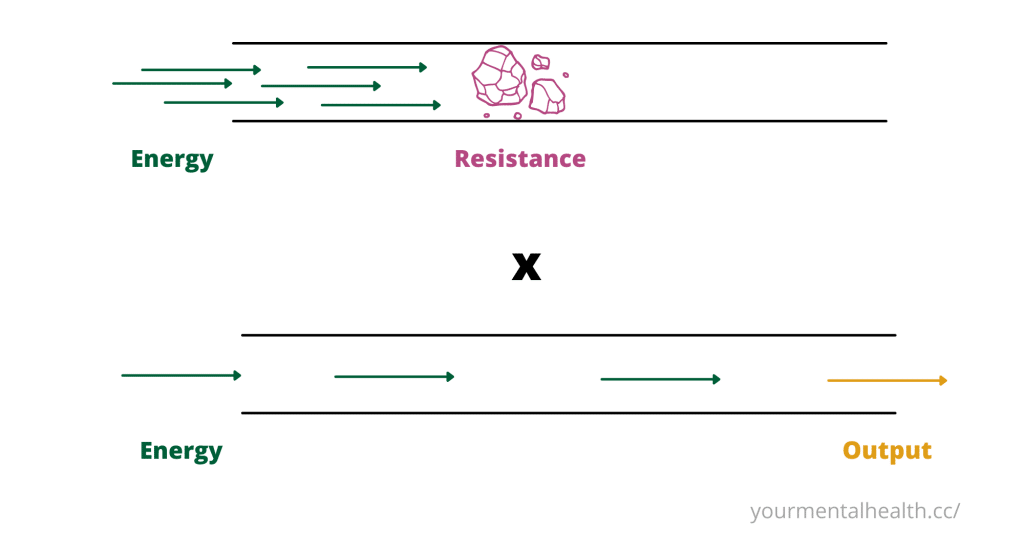
Instead, a more functional solution is to reduce the resistance and clear that blockage. Then, suddenly, the amount of energy dispensed is less, and you get more out of it.
Action
Setting the right kind of goal is really important. We can take a few defined steps to make this happen:
- Focus on yourself
People often look around at other people to find their goals and try to replicate exactly what they are doing. Instead, they should understand themselves and their own needs. - Set appropriate goals
Factor in your strengths and weaknesses. - Develop an action plan
When developing an action plan, probably, you won't get 100% right the first time, but it's essential to start. - Have compassion
You should always be compassionate with your trials and errors. - Iterative approach
Be sure to iterate. Each time something goes wrong, rethink your strategy and change your action plan.
4 types of intent
Why do people choose their goals?
There are different reasons why people choose their goals and do what they do.
- Pressure: we'll often hear the words "need", "should." It can come from society/family expectations.
- Values: we'll often hear the words "care about."
- Duty: often associated with the words "responsibility" and "obligation"; it's owed to someone else; not to be confused with the things that you should do but don't necessarily owe to someone else, like eating healthier.
- Desires: what we want.
Some of these result in a loss for us, making us give something up; others result in a gain for us.
Another dimension to consider when examining intent is the external reward and internal reward.
External rewards include bodily satisfaction or pleasure. Internal reward involves personal satisfaction and does not have to involve prestige or bodily satisfaction.
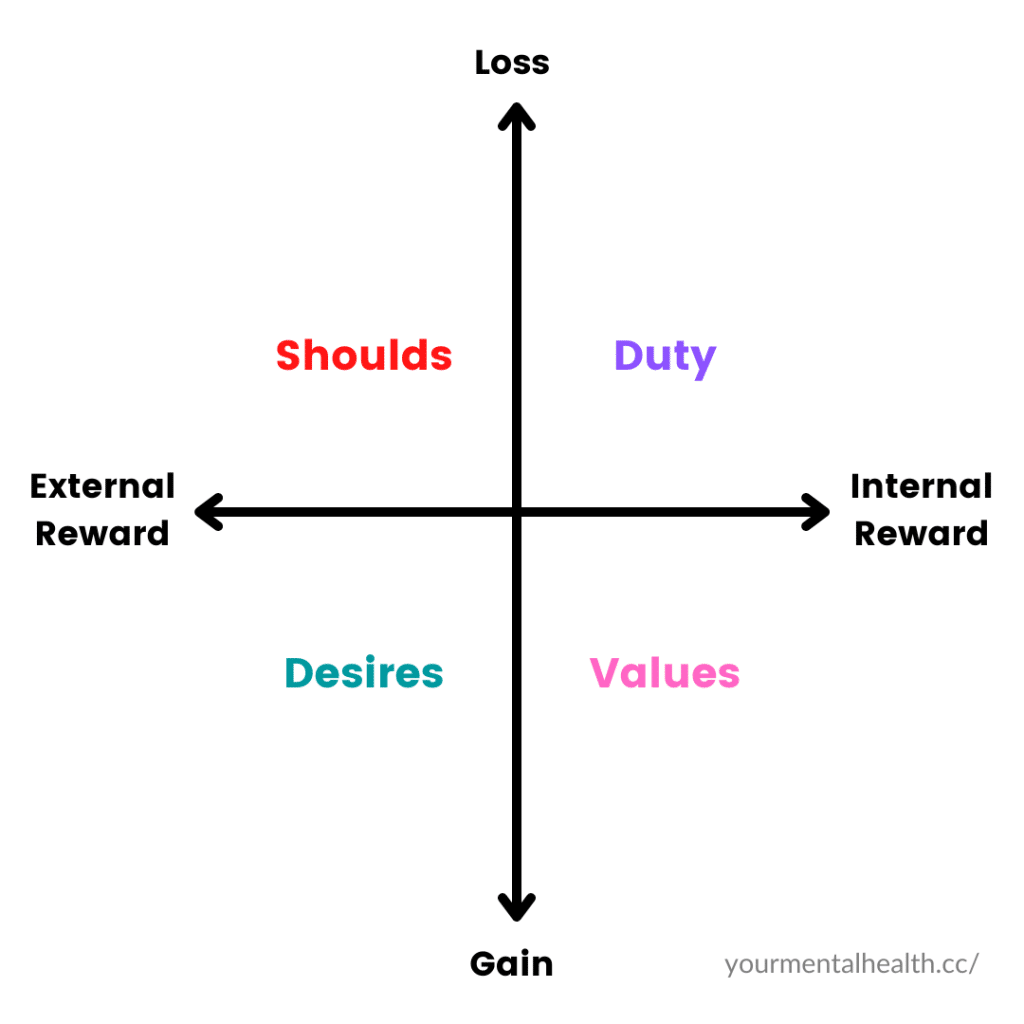
Most people operate from the left side of the quadrant, so they are living from "shoulds" and "desires." This can sometimes make people happy, but it's living a life of external reward.
When people move from the left to the right quadrant, the motivation moves in a positive direction. We will feel good about ourselves and we will take control of our lives.
To move to another quadrant, we need to create awareness and understanding. This way, we can connect with our values and understand where our intent comes from.
If we can uncover what about our actions aligns with us, "should" is not so vague anymore and it increases the internal reward it brings. Creating a plan of action that aligns with our values will then result in a positive change.
Raising the awareness of negative
When we first create our goals, we often do not think of the other emotions involved and what it takes to reach that goal.
It is important to raise awareness of the negative, because it helps in the following ways:
1. Expectations are fixed
The primary emotions that people feel when they think about fulfilling their goals involve overall positive emotions like excitement, achievement, and pride. This is the default reaction when people first create goals.
When people think about goals in a positive way, an expectation is created. Then after taking action, their expectations are often unmet, and motivation decreases. This is why it's important to raise awareness of the negative.
For example, we want to lose weight. We are excited and pumped when we decide that we want to become thinner. But when we go to the gym, we have difficulty doing the exercises. Not only that, we see thinner people than us there. After a week of working out, we still don't see the expected results, our motivation plummets, and expectations shatter.
When we raise awareness of the negative, we can begin to set realistic expectations.
Setting inappropriate expectations will only tank our motivation and lead us to quit. This can make us feel ashamed and think of ourselves as quitters. This cycle happens really fast, and it begins with unrealistic expectations.
As we learn to expect appropriate events and results, it'll disable the cycle and help us become more motivated.
2. Ambivalence is cleared up
There is a conflict that exists between the quadrants and the four types of intent that can be seen as ambivalence. Ambivalence is when we're sitting on the fence.
We often think about what we want to accomplish, but we don't really appreciate what keeps us from accomplishing it.
When we're stuck, there's always a pro in continuing the behavior that keeps us from our goals. That is where our brain tends to focus. For example, we want to get good grades but we play video games more than we study.
By raising awareness of the negative, we highlight the cons. This helps us understand what's on the other side of the equation instead of just focusing on the pros.
In highlighting the negative and clearing the ambivalence, positive change can begin to happen.
We can't move past ambivalence and internal conflict if we don't know what the internal conflict is.
We need to understand that we make a choice every day and that it's up to us to choose who we want to be. Do we want to live a life that is in service to our "values" or our "shoulds?"
3. The cost motivates people
Once the cost of a behavior increases in our mind, you would think that it would decrease the likelihood of us engaging in this behavior.
However, increasing the cost can sometimes drive behavior.
This may seem like a paradox, but take wine tasting for example.
People have done studies on wine tasting, and they found that when you don't tell the price of the bottles to wine tasters, people can't tell that the priciest wines actually taste better. Now, when wine tasters do know the prices, they rank the pricier wines higher. Interestingly, the price drives the perception of quality and value.
To put that into the perspective of goals, if we want to quit gaming, for example, we need to recognize the costs it will entail - that is, we'll feel shame, loneliness and boredom.
Once we're aware of the negative costs and have a realistic expectation, the first steps toward our goals will not seem as bad ("it wasn't that bad"). It then increases our motivation to continue that behavior.
How raising awareness changes people
There are 2 ways we become aware: objective information and subjective understanding. Subjective understanding is responsible for changes in behavior.
The information does not change behavior, but understanding does.
In science, different types of memories have the same idea.
- Explicit Memory
There's explicit memory, which involves information, facts, and memories. This includes things like where you live, your age, etc. It's stored in the hippocampus. - Implicit Memory
Implicit memory is about understanding. As we develop understanding, the information moves from the hippocampus to other parts of the brain, such as the frontal lobe and neocortex. This memory is strengthened during our sleep and it is based on our experiences. People need to practice this memory over time.

The "shoulds" come from explicit memory and they don't drive our behavior.
Implicit memory results in impulse control. This type of memory is not a fact, it's an understanding that was literally processed by your brain.
This is why raising awareness helps people to do a behavior later on. It's not because you were told to do it, but because you were made aware of it.
Resistance vs. Intent
Resistance vs. Intent vs. Action
A lot of times, people know what they need to do but they don't know how to do it. They'll even think of themselves as lazy, undisciplined, or unmotivated.
People often describe themselves this way because they look inside to see themselves struggling to do something and they'll observe someone else's successful external behavior without understanding their emotional struggle. They tend to compare themselves to others and unconsciously create resistance towards their goal.
Signs of resistance
We can spot signs of resistance when we hear phrases like:
- "I want to, but..."
- "It's hard..."
- "It won't be enough..."
- "I can't..."
- "I'm not that..."
- "It's not possible..."
- "I just need to figure out..."
- "I'll be ready when..."
- "I don't know how..."
- "There's no point..."
- "It'll be a waste of time if it doesn't work..."
- "How do I know it'll work..."
- "I'm different from other people with this problem"
- "I've tried it before..."
These are what peoples' thought process manifests as, but this is not the problem. This is only a manifestation of resistance.
Resistance can also include cognitive biases and schemas.
It's hard to recognize our own biases. People can recognize their cognitive bias in some intellectual way; they can know their biases from an explicit memory standpoint, but it's harder to understand it implicitly.
Where the resistance comes from
These statements come from
- Undigested emotions
- Past experiences (when they tried something unsuccessfully)
Past experiences come with emotions. When we have an unpleasant experience, many times we just distract ourselves to overcome it and the emotions go dormant. Our brain then scans the present moment and the emotion returns the next time you engage in a similar situation. So even though it's a new experience and circumstance, we feel like something will go wrong.
Emotions that cause people to resist taking action: fear, hurt, shame, pressure, embarrassment, guilt, alienation, frustration, powerlessness, hopelessness, loneliness, anger, resentment.
The avoidance of these negative emotions motivates people to stay stuck.
People that are stuck are not lazy. They're, in fact, really motivated, but they're motivated to do nothing.
"Being stuck" does not mean one set scenario. It can mean differently to people. You can be in a relationship that you don't enjoy because you think you won't get anything better than what you currently have. Or maybe you're in a six-figure job, but don't feel happy on a day-to-day basis and are unsure how to change your life.
The Sense of I
Over time, as we develop negative experiences, we develop an ego that protects us from negative emotions.
When we feel insecure, we tend to compare ourselves, over rationalize, and pump ourselves up by putting other people down.
Many times, people have a sense of identity that prevents them from acting. They've built a construct of themselves that doesn't allow them to succeed. Who we are factors into our perception of success.
Our brain makes the following calculation:

If we have an identity that views us as a failure, this identity destroys our motivations.
One of these built identities can be of a victim. When the person thinks of themselves that way, then they don't have to take responsibility and face negative emotions.
What to do to change the perception
First, we can uncover the emotion and then metabolize it. This is also known as "emotional catharsis." That's when things become implicit memory.
Secondly, we can redirect the neuronal pathway. This means that our neurons tend to follow certain paths; human beings have scripts running through their minds.
As we uncover our emotions, we can redirect our thinking in a more positive way. Over time, our way of thinking becomes more and more solidified.
Through questions and reflections, we can start thinking about things in a new way. When we reinterpret our understanding, we will actually redirect our neuron pathway and begin the change.
The way to change
Focusing on patterns rather than outcomes is one of the ways to become more action-oriented. The question is stated as, "What's the pattern here?"
For example, when someone adopts a diet but after four days, "cheats". This comes from a number of judgments, like "I failed", "I'm undisciplined", etc. However, what you should be focusing on in this situation is the pattern. Why were you able to succeed for 4 days? What happened on day 5?
This way, you'll better understand the reasons behind your actions. The responsibility of the success or the failure is no longer on the person. It now has to do with the actions and the environment.
Motivation and Goals
Setting a goal
There are several reasons why people create goals. Most people set goals based on what others are doing. Others choose goals for achievement; they think about the end of the road and the target. Others choose goals because they are chasing a feeling.
More often than not, goal-setting is not systematically created and that is one of the problems. We create unreal expectations and ideas.
The 25% rule
Here, we want to recognize where we are and where we want to go. Pinpoint the halfway point between that (50%) and then further narrow down the halfway point between that (25%).
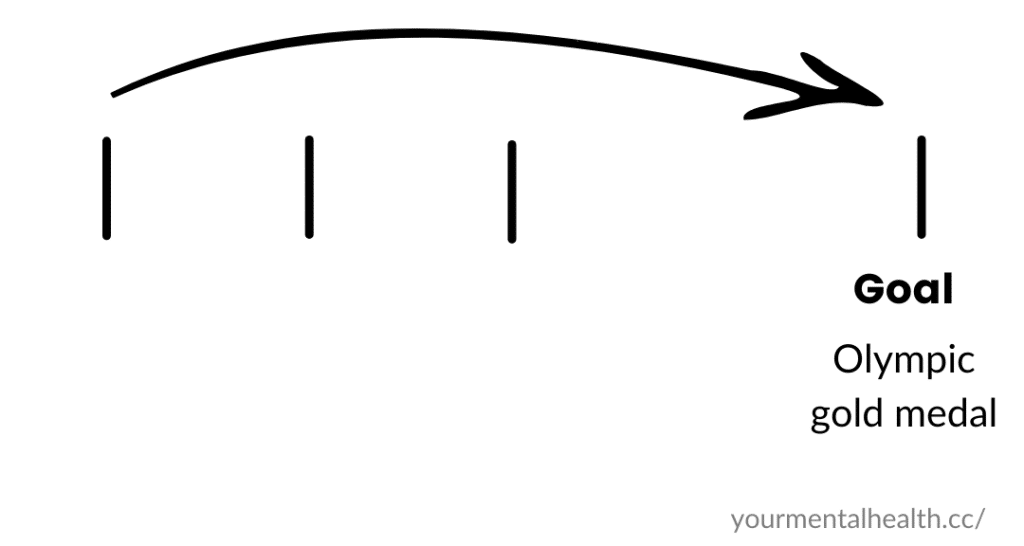
There are a lot of things that we engage in when we do this process.
Our brain can measure the progress towards something. When the gap between what we're capable of and what we want to achieve is wide, it decreases motivation.
Because of that, the first thing we're gonna do is shrink the goal to the first target. This way, we increase the likelihood of positive reinforcement and we open ourselves up to being successful.
To set these goals, ask yourself questions like:
- Where can I start?
This emphasizes the first target rather than the final goal. Focusing on the start dismantles the "not enough" mentality. - What did I do over the last week?
This emphasizes where we are. Ask yourself what you did over the last week that's helping you move towards your goal. We figure out your baseline. People usually don't think of where they are as the baseline but as a negative; they will just usually see a deficit and how they are lacking. - What's one step you can take above the baseline?
This adjusts expectations, has present focus, meets people where they're at, and models acceptance; these all lead to increased success.
To give an example, someone wants to become healthier. The person can ask themselves what they did last week. They realize that they didn't exercise and ordered take out every day. They acknowledge that this is their baseline and they must think of a reasonable goal for next week. They might then decide to work out one day during the next week, and this will be their first target.
Evidence-based goal setting
There are a number of different kinds of scientific principles that we can leverage to optimize how to set a goal.
1. Explore your options
Giving yourself a single path to follow and telling yourself to "just do it" won't work in the long term. It often invalidates your situation and tends to come from a gut reaction. If you want to engage in a behavior, instead of giving yourself a set solution, explore options to choose from. You will likely gravitate towards the most doable scenario.
2. Operationalizing
Operationalizing a problem means breaking down a problem or making something concrete. It increases the number of achievable steps. We have this part of our brain called the frontal lobe that is good with operationalizing. The frontal lobe is responsible for executive function, which is the ability to plan and execute tasks. For example, if we ask a 2-year-old to clean their room, they won't be able to, because their frontal lobe can't grasp this abstract request yet. What we need to do is break down "clean your room" into tasks, like "put away your books" and "put your pencils in the box". This is the process of executive function. It's difficult to do that, but it helps us define achievable steps. As we practice, our brains will be able to operationalize much better.
3. Dunning-Kruger Effect
When we learn how to do an activity, we start where we're unconsciously incompetent, move to conscious competence, and finally end up at conscious incompetence. In this last stage, the behavior becomes easy and natural to do for us.
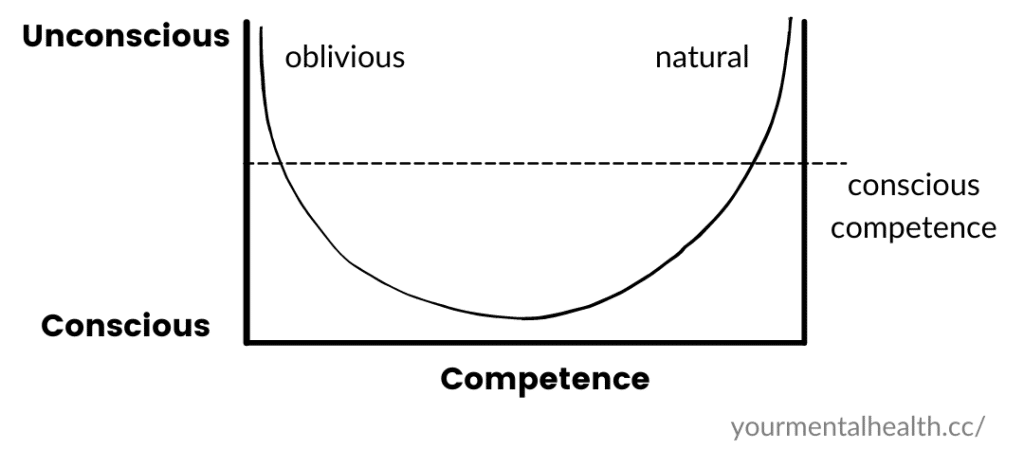
A lot of times, when we want to achieve our goals, we want to move from unconscious incompetence straight to unconscious competence. We want to emphasize the conscious thought process, problem-solving, and mindfulness. In doing so, we start thinking methodically and critically. Our understanding will precede the change that we want to bring about.
Troubleshooting goal setting
There are several difficulties surrounding goal-setting. Here are common challenging scenarios:
- When we have no goals
When we lack goals, we need to understand where we are right now. What makes it hard for us to pick a direction? - When we have overly ambitious goals
Here we can start with the 25% rule. We should recognize when we are comparing ourselves to others or following "should" goals. We might feel like smaller goals are "not enough" which is why we create unrealistic and overly ambitious goals.
Most of the time, "enough" is not a thing. Whether we do something that is enough or not enough is completely independent of what we do. We can study every day, and maybe that'll be not enough, but this shouldn't determine our actions in the present.
The problem with the idea of "not enough" is that it paralyzes us from taking action. - When we have misdirected goals
Sometimes, we simply have the wrong goals. Imagine we're in a boat and there's water coming in, and instead of plugging the holes, we're trying to find a bigger bucket to remove the water.
This can happen to our goals, usually caused by suppression, cognitive biases, blind spots, and such.
Iteration
This approach is not meant to make us achieve our goal, but to iterate. Success is not our target, learning is our target.
Sometimes we'll succeed, and other times we'll fail. What we should do is analyze why we failed.
Oftentimes, when we have goals and fall short on them, our emphasis is on the failure, and what we could do better. However, the interesting thing is that the recipe to success is not necessarily on what we could do better, but on the number of times that we already succeeded.
This is known as the principle of positive deviance, which says that if you're trying to fix a problem, don't focus on the attempts that failed, but on the attempts that you succeeded.
Dimensions of goals
When we think about a goal, there's a lot of value to be gained from breaking apart motivation into multiple things. We can adjust the levers and increase the precision in which we can make changes.

What we're gonna do is expand the precision with which we look at a goal.
Here are the dimensions of a goal. Each of these dimensions can be changed and adjusted to help us gain success:
1. Target
This is what we think traditionally as the goal.
This is where the 25% rule comes in.
2. Actions
This is where operationalizing comes in. Oftentimes we set goals that are not actions, so to explicitly take a goal and reduce it to action will make things easier to do. It will turn the abstract into the concrete.
3. Examples of success and failure
We can explore how we feel about our attempts, successes and failures. What are the key takeaways from these experiences?
Once we make these conscious, we have increased our ability to engage in them again.
This is also an opportunity to explore our resistance. We can ask ourselves "What got in the way?"
4. Physiologic factors
People could have circadian rhythm disorder, vitamin D deficiency, thyroid dysfunctions, testosterone deficiency, vitamin B deficiency, or others.
There can be a number of physiological factors that go into motivation. This is also where sleep, diet, and exercise come into play.
5. Psychological stressors
If you're overwhelmed or stressed, or had a bad interaction at work, that's gonna impact your RAM (working memory). There are all kinds of psychological stressors that can contribute to you not achieving your goals.
You can reflect on what's been stressful for you in the last week. And when things get stressful, how do you think that'll affect your ability to meet your goals.
Generally speaking, people tend to come to the conclusion that "if I were better", "if I could manage stress better", "then I would succeed". That implies that the failure is theirs.
But by pointing out that there are psychological stressors that'll make our life hard, it's easier to forgive ourselves and have self-compassion.
Maybe the solution is not to increase our willpower, but to set better boundaries with people who create stress in our lives, for example.
6. Social influences
This dimension can be parents, roommates, friends, significant others, etc. Here we can explicitly understand the influence of different people in our life.
Who are the people that we hang out with? What do they inspire us to do?
The goal is to be consciously aware of this dimension. When we hang out with our friends, what do they inspire us to do?
Some questions we can ask yourself is "who holds you back?", "who pulls you forward?".
There are some revelations that may appear when we start asking ourselves that.
7. Environmental influences
An example of this dimension is our access to cell phones. Where is it while we're working? Is it locked? Is it in your pocket? Do you have notifications on?
How do you get distracted? When do you get distracted? Where do you study?
Here we want to think about the environmental influences that lead us to success.
8. Stakeholders
What are the different stakeholders for the goal that we're trying to achieve?
Sometimes, for the goals that we have, there are other people that don't want those goals. For example, if you're trying to get promoted.
There are things outside of us that are going to be influencing us, and consciously thinking about those things can help us adapt our goals and actions.
References: